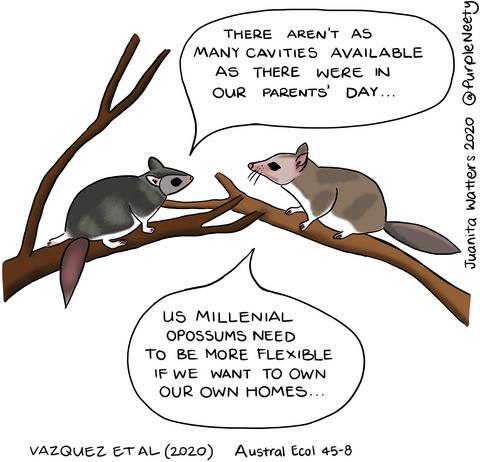当前位置:
X-MOL 学术
›
Austral Ecol.
›
论文详情
Our official English website, www.x-mol.net, welcomes your
feedback! (Note: you will need to create a separate account there.)
Austral Opossum adjusts to life in second‐growth forests by nesting outside cavities
Austral Ecology ( IF 1.6 ) Pub Date : 2020-07-03 , DOI: 10.1111/aec.12927 M. Soledad Vazquez 1 , José Tomás Ibarra 2, 3 , Tomás A. Altamirano 2
Austral Ecology ( IF 1.6 ) Pub Date : 2020-07-03 , DOI: 10.1111/aec.12927 M. Soledad Vazquez 1 , José Tomás Ibarra 2, 3 , Tomás A. Altamirano 2
Affiliation

|
The Austral Opossum is one of the most unique vertebrates in Patagonian forests. It is not only endemic to this habitat; it also plays a key role acting as a seed disperser, nest predator, and is prey to species of conservation concern. However, specific information about its nesting behaviour is scattered and rudimentary at best. Here, we: (i) use personal observations along with published data to group information about nest site choice and (ii) investigate how flexible this behaviour is, examining the relative frequency of both cavity (natural and artificial) and non‐cavity nests. We found that Opossums placed their nests inside cavities 50% of the time in old‐growth forests but only 25% of the time inside cavities in second‐growth forests. We suggest that our naturalist records, along with the previous published literature, might reflect a flexible response of the species to cavity availability. In forests suffering continuous degradation, such as Patagonian ecosystems, this flexible behaviour may increase the likelihood of population persistence in the future. This study leads to the following further questions: is Austral Opossum nesting behaviour phenotypic flexibility or plasticity? Are cavities a limiting resource for this species? Would it be more efficient for a conservation program to install nest boxes or to take actions to encourage the understory vegetation where they can nest?
中文翻译:

负鼠通过筑巢来适应次生林中的生活
负鼠是巴塔哥尼亚森林中最独特的脊椎动物之一。它不仅是该生境的地方性物种;它也起着种子分散器,巢穴捕食者的作用,是保护物种的猎物。但是,有关其嵌套行为的特定信息充其量是零碎的,而且基本没有。在这里,我们:(i)使用个人观察和已发布的数据将有关巢位选择的信息分组,并且(ii)研究这种行为的灵活性,检查空腔(天然和人工)巢和非空腔巢的相对频率。我们发现负鼠在老龄森林中将其巢穴放置在洞内的时间为50%,而在次生森林中只有25%的巢穴放置在洞内。我们建议我们的博物学家的记录,以及以前发表的文献,可能反映了物种对空洞可用性的灵活反应。在遭受持续退化的森林(如巴塔哥尼亚生态系统)中,这种灵活的行为可能会增加未来人口持续存在的可能性。这项研究提出了以下进一步的问题:负鼠巢嵌套行为是表型柔性还是可塑性?腔是该物种的限制资源吗?养护计划安装巢箱或采取措施鼓励可在其下筑巢的地下植被会更有效吗?负鼠的筑巢行为是表型柔性还是可塑性?腔是该物种的限制资源吗?养护计划安装巢箱或采取措施鼓励可在其下筑巢的地下植被会更有效吗?负鼠嵌套行为是表型柔性还是可塑性?腔是该物种的限制资源吗?养护计划安装巢箱或采取措施鼓励可在其下筑巢的地下植被会更有效吗?
更新日期:2020-07-03
中文翻译:

负鼠通过筑巢来适应次生林中的生活
负鼠是巴塔哥尼亚森林中最独特的脊椎动物之一。它不仅是该生境的地方性物种;它也起着种子分散器,巢穴捕食者的作用,是保护物种的猎物。但是,有关其嵌套行为的特定信息充其量是零碎的,而且基本没有。在这里,我们:(i)使用个人观察和已发布的数据将有关巢位选择的信息分组,并且(ii)研究这种行为的灵活性,检查空腔(天然和人工)巢和非空腔巢的相对频率。我们发现负鼠在老龄森林中将其巢穴放置在洞内的时间为50%,而在次生森林中只有25%的巢穴放置在洞内。我们建议我们的博物学家的记录,以及以前发表的文献,可能反映了物种对空洞可用性的灵活反应。在遭受持续退化的森林(如巴塔哥尼亚生态系统)中,这种灵活的行为可能会增加未来人口持续存在的可能性。这项研究提出了以下进一步的问题:负鼠巢嵌套行为是表型柔性还是可塑性?腔是该物种的限制资源吗?养护计划安装巢箱或采取措施鼓励可在其下筑巢的地下植被会更有效吗?负鼠的筑巢行为是表型柔性还是可塑性?腔是该物种的限制资源吗?养护计划安装巢箱或采取措施鼓励可在其下筑巢的地下植被会更有效吗?负鼠嵌套行为是表型柔性还是可塑性?腔是该物种的限制资源吗?养护计划安装巢箱或采取措施鼓励可在其下筑巢的地下植被会更有效吗?











































 京公网安备 11010802027423号
京公网安备 11010802027423号